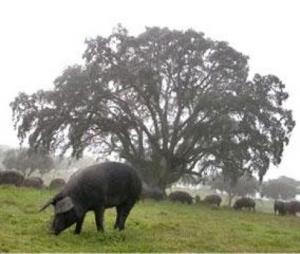The reason that I’m a bit fat is because I like eating fat.
I love eating fat. Pig fat, sheep fat, cow fat. Even fish fat. Though forced to choose three from four I would lose the fish fat. Toro though? Mmmmm. No. Lose the fish fat.
Pig fat is the best fat. Lamb fat and cow fat are equally excellent fats but cannot hold a candle to pig fat. There are two joint top forms of pig fat.  The first of these is the silky pristine white fat found on Gran Reserva Jamon Iberico de Bellota, which after an oyster is the best thing that you can put in your mouth. This is ham made from black leg pigs that gobble up to ten (!) kilos of acorns everyday. The legs are then salted and dried and hung for up to four years to develop their musky, salty, savoury goodness. And then get hand-carved and slapped on a plate at Brindisa or similar for fifteen quid per plate’ful’. And worth every penny, I say. Because you lay a piece on your tongue and your brain goes fuzzy as that transluscent fat melts, coating your mouth in a way that way that evokes the mulch of dead leaves, detritus and acorns upon which these lucky porkers spent their days.
The first of these is the silky pristine white fat found on Gran Reserva Jamon Iberico de Bellota, which after an oyster is the best thing that you can put in your mouth. This is ham made from black leg pigs that gobble up to ten (!) kilos of acorns everyday. The legs are then salted and dried and hung for up to four years to develop their musky, salty, savoury goodness. And then get hand-carved and slapped on a plate at Brindisa or similar for fifteen quid per plate’ful’. And worth every penny, I say. Because you lay a piece on your tongue and your brain goes fuzzy as that transluscent fat melts, coating your mouth in a way that way that evokes the mulch of dead leaves, detritus and acorns upon which these lucky porkers spent their days.
Like truffles, like oysters- this is food as evocation. You can taste the sea, smell the earth, feel the love, pain and labour that went into your mouthful. No silly chef has messed about. It’s just a perfect ingredient. And some people will, clutching a knife and fork in their prissy, bony fingers, cut off the fat and push it with distaste to the side of their plate. Should I happen to be walking past I will pop it in my mouth so as to not disrespect the pig or producer. This is still frowned upon in the more classy Spanish establishments.
And then, OF COURSE, crackling. Who buys a loin or shoulder or belly of pork and asks the butcher to take off the skin. People do! I promise. It defies sense and belief. Good crackling is a mythical beast. I couldn’t marry someone who didn’t like crackling. Or be friends with them. Or possibly resist from bopping them smack on the nose. That golden, crunchy, salty, fat and skin combo. Rendered for hours with gentle heat and then blasted in a furnace to bubble and crisp- shards of umami rich, sweet, salty unctuous protein. Amazing.
I have just, this very morning put four whole pork bellies in my very large commercial oven. I can smell them from where I sit now. I will be serving them at eight o’clock this evening and this afternoon I will be mostly tending to their every whim.
Ask your butcher for a pork belly- bone in, skin on, scored. That will make you sound like you know what you are talking about and feel quite cool. Because belly is a cheap cut- get the best pig you can- saddlebacks and Gloucester Old Spots are good.
Dig out your biggest roasting tray and in it place two sliced onions and three sliced apples. Pour in a couple of bottles of decent cider. Three bay leaves and a few star anise. Place the pork on top and be careful not to get any cider on the scored skin- this will just burn. Crush a couple more bay leaves with plenty of salt and pepper and liberally season the meat.
Put in your oven at 140 degrees for between four and five hours. Then whack it up. As hot as your mere domestic oven will manage. Make it beg for mercy. And then get down on your honkers and watch through the glass as your crackling crackles. Do not for the love of all that is good and true answer the phone or become engrossed in Jeremy Kyle. If you burn your pig now I will personally come round and give you that bop on the nose.
This should take ten maybe fifteen minutes but do keep an eye on it- you know what crackling looks like. When it’s done it’s done. Take it out. Leave the pork to rest. Eat with something to cut through the fats- red cabbage is good here. And of course don’t forget the caramell-y, onion-y, cider-y gravy that you have just unwittingly made.
